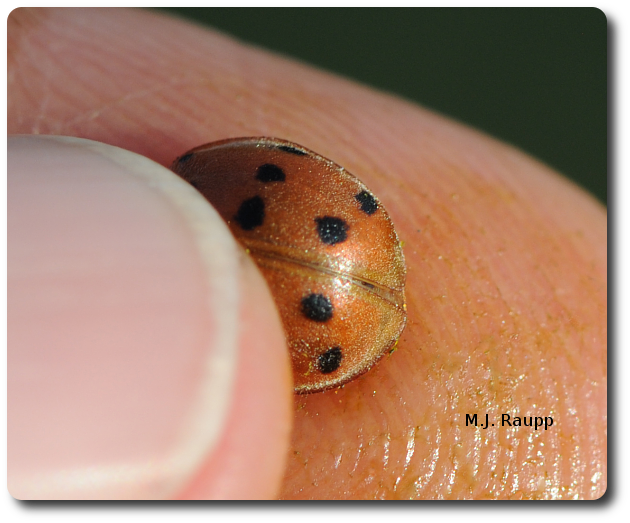Several previous episodes of Bug of the Week such as “Murder and mayhem in aphid land”, and “Death by beetle” featured ladybugs (a.k.a ladybird beetles). These highly beneficial insects keep many pests in our gardens and landscapes at bay. But like many large families, part of the clan sometimes goes astray and beetles in the genus Epilachna evolved to eat plants rather than other insects. The aboriginal home of the Mexican bean beetle is the high southern plateau of Mexico where many members of the bean plant family grow. As beans became widely cultivated in the United States, the Mexican bean beetle crossed the boarder and spread throughout the eastern half of the US where moist conditions and many types of cultivated beans favor its survival.
Mexican bean beetle eggs are laid in large clusters.
In most years Mexican bean beetles are relatively scarce due to control provided by a small parasitic wasp released decades ago in the mid-Atlantic region. However, in a local community garden, this year’s wet spring and mild summer seem to have provided the perfect growing conditions for the bean beetle. Almost every leaf of the snap and lima beans was etched by the feeding of this pest. Bristly, bright yellow larvae fed in groups of 2 or 3. Orange and yellow adults with black spots contentedly munched bean leaves and converted their nutrients into eggs. Each female can lay as many as 600 eggs during the course of a lifetime. Laid by the dozen these bright yellow eggs hatch in about a week. Larvae complete development and form a pupa suspended from the leaf of the bean plant. As summer wanes, adult beetles seek shelter in the form of decaying vegetation or leaf litter to survive the chill of winter. In spring, adults emerge from their refuge and move back to the bean fields to resume feeding and producing pestiferous spawn.
Bean beetle larvae are cloaked in stout spines.
One way to reduce problems caused by these hungry bean-eaters is to remove plant refuse from the garden plot at the end of the growing season. This forces overwintering beetles to take a longer and more perilous journey to and from hibernal refuges. Some gardeners use row covers with a fine mesh to prevent beetles from reaching the bean leaves. These should be put in place early and kept in good repair. Another strategy to confound this pest is to plant a small “trap crop” of a favored food like snap beans in the garden early in the season. This early plot will attract and collect overwintering beetles as they move from their refuges. Once the trap is set and the beetles have moved in, they and the trap crop can be annihilated, thereby reducing the number of beetles remaining to attack the beans planted later for your summer dinners.
References:
Information used in preparing this Bug of the Week can be found at the web sites listed below.
http://www.uri.edu/ce/factsheets/sheets/mexbeanbeetle.html
http://creatures.ifas.ufl.edu/veg/bean/mexican_bean_beetle.htm


